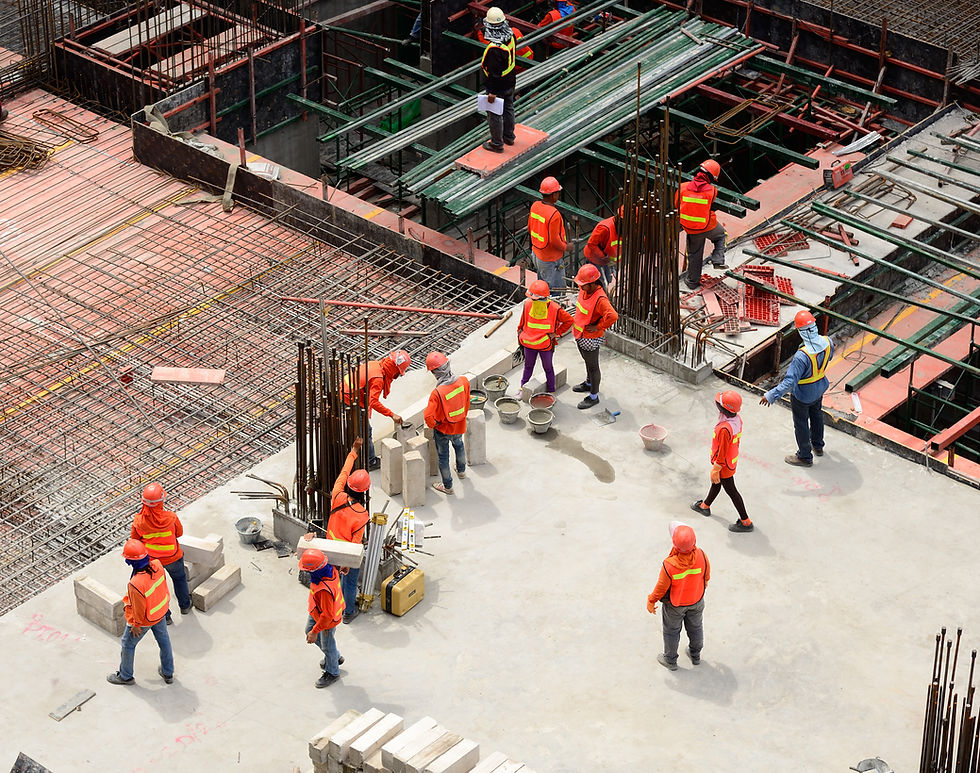Integrating Sustainability into Every Step
- Omega Lee
- Sep 6, 2023
- 3 min read
Advancing Construction Practices

The construction industry plays a pivotal role in shaping the world we live in. It builds the infrastructure, homes, and spaces where we work, live, and play. However, it also bears a significant responsibility for its environmental and social impacts. As we strive for a more sustainable future, integrating sustainability into every step of the construction process has become imperative. This article explores the importance of advancing construction practices by embracing sustainability as a core principle.

The Current State of Construction
The construction industry has historically been associated with resource-intensive practices, waste generation, and a substantial carbon footprint. Traditional construction methods often focus solely on the end product, neglecting the environmental and social implications of the process. The consequences of this approach are becoming increasingly evident in our rapidly changing world.
The Need for Sustainable Construction
Environmental Impact: Construction activities contribute significantly to greenhouse gas emissions, land degradation, and resource depletion. Sustainable construction seeks to mitigate these impacts through efficient use of resources, renewable energy adoption, and responsible waste management.
Social Responsibility: Construction projects can disrupt communities, displace people, and contribute to inequality if not planned and executed with social responsibility in mind. Sustainable construction aims to engage with local communities, provide fair working conditions, and enhance social well-being.
Economic Benefits: Sustainable construction practices can lead to long-term economic benefits by reducing operational costs, improving energy efficiency, and increasing the lifespan of buildings and infrastructure. It also opens up new markets and opportunities for innovation.

Integrating Sustainability into Every Step
Design Phase: Sustainability starts with the initial design. Architects and engineers must consider factors such as site selection, energy efficiency, and material sourcing. Innovations like Building Information Modeling (BIM) enable professionals to create highly efficient and sustainable designs.
Material Selection: Sustainable construction emphasizes the use of eco-friendly materials, such as recycled or renewable resources. This reduces the environmental impact of construction and promotes a circular economy.
Construction Techniques: Adopting eco-friendly construction techniques, like modular construction and prefabrication, can significantly reduce waste and the carbon footprint of a project. It also allows for faster and more efficient construction.
Energy Efficiency: Implementing energy-efficient technologies and renewable energy sources, such as solar panels and geothermal systems, can dramatically reduce the energy consumption of buildings and infrastructure.
Waste Management: Proper waste management practices, including recycling and reusing materials, can minimize the volume of construction waste sent to landfills.
Maintenance and Operations: Sustainable construction extends beyond the completion of a project. Regular maintenance and energy-efficient operations are essential to ensure that the sustainability goals are met throughout a building's lifecycle.

Case Studies in Sustainable Construction
Numerous projects worldwide exemplify the successful integration of sustainability into construction practices. The One Angel Square building in Manchester, UK, is a prime example. It is one of the world's most sustainable buildings, featuring energy-efficient design, natural ventilation, and on-site renewable energy generation. The California Academy of Sciences in San Francisco is another noteworthy project, with its living roof, energy-efficient systems, and commitment to education on sustainability.

Conclusion
The construction industry stands at a crossroads, where it must embrace sustainability as a fundamental principle of its operations. Advancing construction practices to integrate sustainability into every step is not only necessary but also holds the key to a more resilient and prosperous future. By adopting sustainable design, materials, techniques, and operations, the industry can reduce its environmental footprint, enhance social responsibility, and reap economic benefits. It's time to build a better world, one sustainable construction project at a time.
Where to get experienced Architects, Engineers, and Contractor in Malaysia
Aathaworld Sdn Bhd, with years of industry expertise, we deliver exceptional construction solutions, blending innovation with proven methods to exceed client expectations. We do supply projects in KL Kuala Lumpur, Selangor, Klang Valley, JB Johor Bahru, Penang, Malacca (Melaka), Seremban Negeri Sembilan, Perak, Pahang, Kuantan, Kelantan, Terengganu, Perlis, Alor Setar Kedah, as well as Sabah and Sarawak for East Malaysia. Engage with us also for your projects, construction design, supply or installation in Southeast Asia (SEA) countries, including Singapore, Myanmar (Burma), Cambodia, Vietnam, Laos, Thailand, Indonesia, Philippines, Brunei, Bangladesh as well as China, Taiwan, Hong Kong, Australia and New Zealand. Submit to us now for your project sourcing requirement, whether you are looking for manufacturing, construction side, packaging, retail usage or more as we can provide the best solution for your specific requirement and other areas at info@aathaworld.com or call (WhatsApp) at +(60)11-7001 1003 (Monday to Friday) or +(60)11-1188 1003 (Saturday, Sunday & Public Holiday).
Photo Credit: Media from Wix







Commentaires